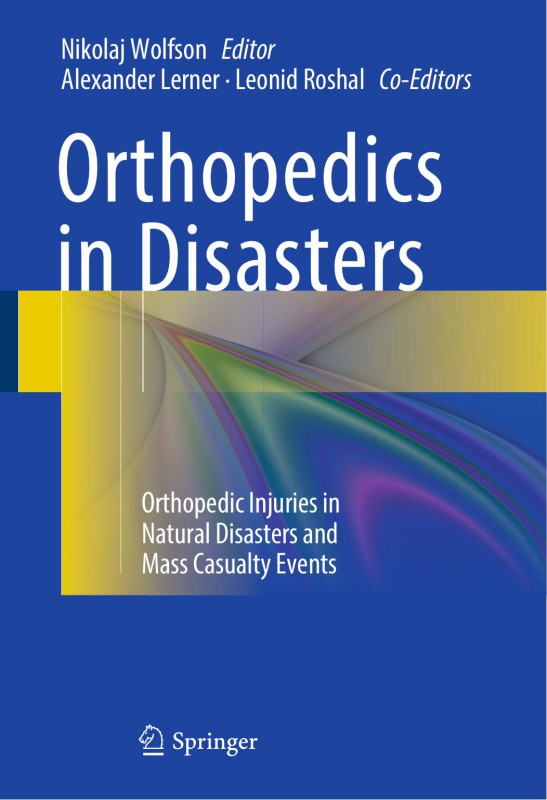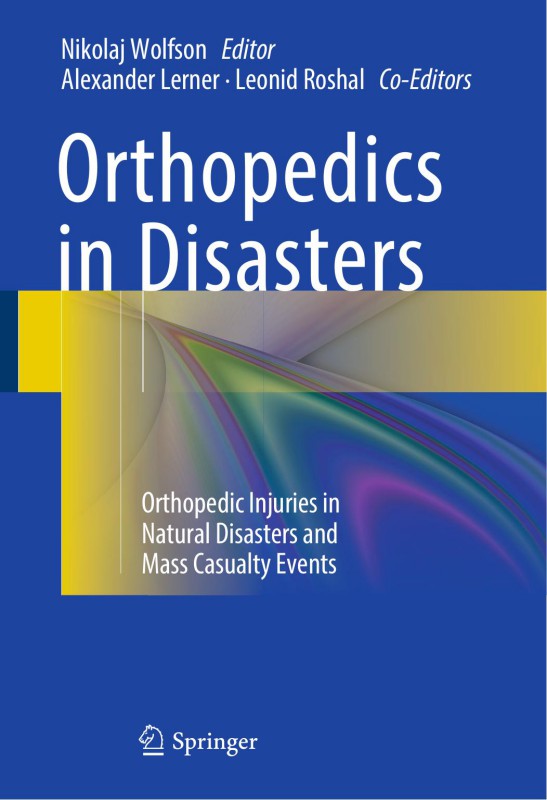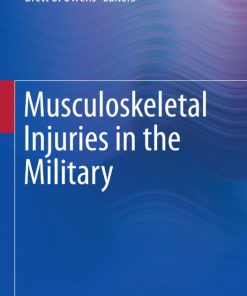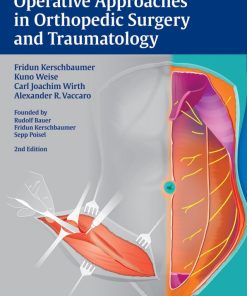Orthopedics in Disasters Orthopedic Injuries in Natural Disasters and Mass Casualty Events 1st Edition by Nikolaj Wolfson, Alexander Lerner, Leonid Roshal ISBN 9783662489505 3662489503
$50.00 Original price was: $50.00.$25.00Current price is: $25.00.
Authors:Nikolaj Wolfson, , Series:Surgery [63] , Tags:Medical › Surgery › General Medical / Clinical Medicine Medical / Emergency Medicine Medical / Orthopedics Medical / Surgery / General , Author sort:Nikolaj Wolfson, , Languages:Languages:eng , Published:Published:May 2016 , Publisher:Springer , Comments:Comments:This book is the first to address specifically the mechanisms and treatment of orthopedic injuries due to natural disasters and other mass casualty events. Casualty management is discussed in a range of contexts, from earthquakes and tsunamis to terror attacks and combat situations. Organizational aspects are addressed, general treatment principles are documented, and the management of a variety of orthopedic injuries is described with the aid of numerous illustrations. The book will serve as an invaluable source of practical knowledge for a broad spectrum of medical and other staff, including emergency personnel, orthopedic and trauma surgeons, general practitioners, medical students, and professionals working for the military, government bodies, and NGOs.​
Orthopedics in Disasters Orthopedic Injuries in Natural Disasters and Mass Casualty Events 1st Edition by Nikolaj Wolfson, Alexander Lerner, Leonid Roshal – Ebook PDF Instant Download/Delivery. 9783662489505 ,3662489503
Full download Orthopedics in Disasters Orthopedic Injuries in Natural Disasters and Mass Casualty Events 1st Edition after payment
Product details:
ISBN 10: 3662489503
ISBN 13: 9783662489505
Author: Nikolaj Wolfson, Alexander Lerner, Leonid Roshal
Orthopedics in Disasters Orthopedic Injuries in Natural Disasters and Mass Casualty Events 1st Edition Table of contents:
Part I: General Overview of Disaster and Mass Casualties Management: Organization
1: Introduction
2: Epidemiology and History of Natural Disasters and Mass Casualties
2.1 Introduction
2.2 The Study of Disasters and the History of Disaster Response
2.3 Terminology Used in Disaster Management
2.3.1 Hazard
2.3.2 Vulnerability
2.3.3 Capacity
2.3.4 Disaster Cycle
2.3.5 Mass Casualty
2.3.6 Humanitarian Crisis
2.3.7 Complex Emergency
2.4 Factors That Influence the Epidemiology of Disasters
2.4.1 Climate Change
2.4.2 Urbanization and Deforestation
2.4.3 Poverty
2.4.4 Political Instability
2.4.5 Conflict
2.4.6 Migration and Displacement of Vulnerable Populations
2.4.7 Failure of States to Develop Post-conflict
2.4.8 Global Finance and Trade Agreements
2.4.9 Failure of the International Community and Humanitarian Aid
References
3: Warfare Medicine: Historical Perspectives
3.1 War-related Orthopedic Injuries
3.1.1 Introduction
3.1.2 Ancient Warfare BC
3.1.3 Warfare AC
3.1.3.1 Napoleonic War (1803–1815)
3.1.3.2 The American Civil War (1861–1865)
3.1.3.3 Boer War (1899–1902)
3.1.3.4 World War I (1914–1918)
3.1.3.5 World War II (1939–1945)
3.1.3.6 Korean War (1950–1953)
3.1.3.7 Vietnam War (1959–1975)
3.1.3.8 Operation Iraqi Freedom (OIF) and Operation Enduring Freedom (ODI)
3.2 Military Health System
3.2.1 Introduction
3.2.2 Role I–IV Levels of Care for NATO
3.2.3 Echelons I–V of Care for US Forces
3.2.4 Development of the Military Field Hospital
3.2.5 Development of the Mobile Army Surgical Hospital (MASH)
3.2.6 Development of the Forward Surgical Team (FST)
References
4: Emergency Medical Services
4.1 Introduction
4.2 EMS: What Is It and Why Does It Concern Me?
4.2.1 Mission
4.2.2 Community and EMS
4.2.3 Components of an EMS System
4.2.3.1 Dispatch
4.2.3.2 First Responders and Special Teams
4.2.3.3 Providers
4.2.3.4 Hospitals and Specialty Care Centers
4.2.3.5 Quality Improvement (QI)
4.3 Military and Civilian Innovation
4.4 Models of EMS Delivery
4.4.1 Provider Entities
4.4.2 Levels of Training
4.4.3 Physician Staffed Resources
4.4.4 Advanced Technician Staffed Resources
4.4.5 Basic Technician Staffed Resources
4.5 EMS in Practice
4.5.1 Normal Operations
4.5.2 Disaster Operations
4.5.3 Disaster Planning in EMS
4.6 Summary
5: Treatment Capabilities of Field Hospitals at War and Mass-Casualty Disasters
5.1 Introduction
5.2 Field Hospitals: A Historical Perspective
5.3 Field Hospitals of the Israeli Medical Corps: Structure and Function
5.4 The Haiti Experience: An Airborne Field Hospital in Action
5.5 Summary
References
6: Role of Government and NGOs
6.1 Introduction
6.2 Stakeholders
6.2.1 Local Government
6.2.2 Military and Uniformed Services Groups
6.2.3 Foreign Responders
6.2.4 United Nations Affiliates
6.2.5 Global Professional Associations
6.2.6 Nongovernmental Organizations
6.2.6.1 The Main Issue with NGO Activities in Disaster
6.2.6.2 Government: NGO Collaboration
6.2.7 Hybrid Organizations
6.2.8 The Mass Media
References
7: Civilian Hospital Role in Mass Casualty Event (MCE)
7.1 Introduction
7.2 General Principles
7.2.1 Hospital Readiness and Preparedness
7.2.2 Management at the Hospital Level
7.2.3 Step-by-Step Management of Emergency Events at the Hospital Level
7.2.3.1 Phase 1: Preadmission Preparedness
Notification, Validation, and Decision-Making
Role Assignment
7.2.3.2 Phase 2: Management of the Emergency Event
7.2.3.3 Phase 3: Debriefing and Lessons Learned
7.2.3.4 Evaluation of the Model
7.2.4 Training International Teams for Mass Casualty Situations
7.2.4.1 Topics of Courses and Workshops
Organizing a Trauma System
Mass Casualty Situations (MCS)
7.2.5 Summary and Conclusion
7.3 Mass Casualties: Preparedness, Orthopedic Trauma Service, Hadassah Hebrew University Medical Ce
7.3.1 Rationale
7.3.1.1 Primary Blast Effect
7.3.1.2 Secondary Blast Effect
7.3.1.3 Tertiary Blast Effect
7.3.1.4 Quaternary Blast Effect
7.3.2 Preparedness
7.3.2.1 Surge Capacity
7.3.2.2 Triage
7.3.2.3 Damage Control Strategy
7.3.2.4 Information Centers
7.3.3 Diagnostics and Management
7.3.3.1 The Morning After
7.3.4 The Role of Orthopedic Surgery in Mass Casualty Events
7.3.5 Benefits and Risks
7.3.6 Summary
References
8: Individual Preparedness in Disaster Response
8.1 Introduction
8.2 Core Competencies
8.3 Psychosocial Competencies
8.4 New Challenges
8.5 The Americas
8.6 Europe
8.7 Asia-Pacific
8.8 International NGOs
8.9 Red Cross and Red Crescent Movement
8.10 Format of Training
8.11 United Nations Affiliates
8.12 Telemedicine
References
9: Orthopedic Equipment Needs in Disaster Setting
9.1 Introduction
9.2 General Equipment Needs for Initial Response Team
9.2.1 Portable Power Generator
9.2.2 Portable Sterilizator
9.2.3 Electrocauter Device
9.2.4 Tourniquets and Topical Hemostatic Agents
9.2.4.1 Tourniquets
9.2.4.2 Hemostatic Agents
9.2.5 Suction Device
9.2.6 Antibiotics, Analgesics, Tetanus Toxoids and/or Tetanus Immunoglobulins, and Irrigation Solu
9.2.7 Plaster of Paris (PoP) Cast, Padding, Elastic Bandage, and Cast Cutter
9.3 Wound Dressings Including Negative-Pressure Wound Therapy (Wound VAC System)
9.4 Skeletal Traction
9.5 Skin Traction
9.6 Basic Surgery Set, Suture Materials, Gigli Saw
9.7 Arm Sling
9.8 Orthopedic Equipment Needs for Secondary Response Team
9.8.1 External Fixation Set
9.8.2 Basic Orthopedic Instrument Set, Small and Large Fragment, Instrument Set for Nailing
9.8.3 Battery-Operated or Electric Power Drill
9.8.4 Orthopedic Implants
9.8.5 Dermatome
9.8.6 Assistive Device
References
Part II: General Overview of Disaster and Mass Casualties Management: Orthopedic Injuries of Specifi
10: Traumatic Injuries During Earthquakes
10.1 Earthquakes
10.1.1 Surgical Care in Natural Disasters
10.1.2 Surgical Care in Earthquakes
10.1.3 Orthopedic Care in Earthquakes
10.1.4 Ethical Considerations
10.1.5 Cultural Factors
10.2 The Main Types of Damage Caused by Earthquakes
10.2.1 Fractures
10.2.2 Amputation
10.2.3 Crush Injuries, Crush Syndrome, and Compartment Syndrome
10.2.4 Polytrauma and Multiple Trauma
10.2.5 Circulatory Shock
10.2.6 Concomitant Injury to the Brain
10.2.7 Combined Spinal Cord Injury
10.2.8 Combined Chest Trauma
10.2.9 Combined Abdominal Trauma
10.2.10 Concomitant Injury of the Musculoskeletal System
10.2.11 Combined Injury of Two or More Cavities
10.3 Discussion
References
11: Tsunami and Flood
11.1 Introduction
11.2 Type of Orthopedic Injury by Tsunami
11.3 The Infections and Treatment of Wounds
11.4 Communications and Cooperation
11.5 Medical Facility and Relief
11.6 Learning from Tsunami Experience and Damages
References
12: Nuclear Disasters
12.1 Introduction
12.2 Radiation Exposure and Pollution
12.3 History of Major Nuclear Reactor Accidents [3, 4]
12.4 Types of Radiation
12.4.1 Alpha Rays
12.4.2 Beta Rays
12.4.3 Gamma Rays (Almost Equal to X-Rays)
12.5 Half-Life of Radioactive Materials
12.6 Special Radiation Units
12.7 Outline of the Radiation Medicine [5]
12.8 Patients with External Radiation Exposure (Can Be Lethal)
12.9 Radiation Tissue Damage
12.9.1 Bone
12.9.2 Nerves and Muscle
12.9.3 Skin
12.10 Patients Contaminated with Radioactive Materials (Radionuclides)
12.11 Healthcare Workers’ Radiation Exposure
12.12 Healthcare Facility Management
References
13: Orthopedic Injuries in Transportation Disasters
13.1 Introduction
13.2 Survey
13.3 Injuries in Fatal Aircraft Accidents
13.4 Trauma System
13.4.1 Trauma System Components
13.4.2 Public Information, Education, and Injury Prevention
13.4.3 Human Resources
13.4.4 Prehospital
13.4.5 Communication System
13.4.6 Medical Direction
13.4.7 Triage and Transport
13.5 Conclusion and Orthopedic Surgeon Role
References
14: Terror-Related Trauma
14.1 Preface
14.2 Mechanism of Injury
14.2.1 Radiological Terrorism
14.2.2 Biological Terrorism
14.2.3 Chemical Terrorism
14.2.4 Conventional Terrorism
14.2.4.1 Primary Blast Injury
14.2.4.2 Secondary Blast Injury
14.2.4.3 Tertiary Blast Injury
14.2.4.4 Quaternary Blast Injury
14.3 Triage
14.4 Evaluation and Treatment
14.4.1 Patient Evaluation
14.4.2 Treatment: Damage Control Orthopedics
14.4.3 Treatment of Typical Injuries
14.4.3.1 Soft Tissue Injury
14.4.3.2 Fracture Fixation
14.4.3.3 Amputations
14.4.3.4 Shrapnel Injuries
References
Part III: Treatment of Orthopaedic Injuries: General Treatment Principles
15: Battlefield Triage
15.1 Introduction
15.2 History
15.3 Triage Context
15.4 French Army Triage System
15.4.1 Medical Evacuation (MEDEVAC) Categories
15.4.2 French Army Classification
15.5 Triage Systems (Categorisation and Assessment)
15.6 Issues
15.6.1 Logistic Problems
15.6.2 Triage Area
15.6.3 Identification and Registration
15.6.4 Medical Team
15.6.5 Evacuation
15.6.6 Triage Officer
15.7 Ethical Problems
15.7.1 Expectant Cases
15.7.2 Triage and Neutrality
References
16: Fluid Resuscitation in Mass Casualty Incident
16.1 Introduction
16.2 Triage
16.3 Prehospital Care
16.4 Hospital Care
16.5 Resuscitation
16.5.1 Introduction
16.5.2 Volume Resuscitation
16.5.2.1 Fluids Administration
16.5.2.2 Blood and Blood Products Administration
16.5.2.3 Coagulopathy of the Injured
16.5.2.4 Early Transfusion
16.5.2.5 Massive Transfusion (MT)
16.5.2.6 Multiple Transfusion Protocol (MTP)
16.5.2.7 Other Blood Products
Fibrinogen
Lyophilized Plasma
16.6 Imaging
16.6.1 Focused Assessment with Sonography in Trauma (FAST) in MCI
References
17: Transfusion Service and Blood Banking in Natural Disasters
17.1 Introduction
17.2 Guidelines for Blood Centers
17.3 Calculation of Blood Requirement
17.4 Historical Examples of Blood Use in Major Natural Disaster Events
17.4.1 Wenchuan County (Sichuan Province) Earthquake (May 2008)
17.4.2 Haiti Port-au-Prince Earthquake, January 2010
17.4.3 The Great East Japan Earthquake, March 2011
17.5 Coagulopathy of Massively Bleeding Patients
17.6 Blood Products for Bleeding Patients
References
18: Diagnostic Imaging in Mass Casualty Events
18.1 Introduction
18.2 Planning and Setup
18.3 Conventional Radiography
18.4 Ultrasound
18.5 Computed Tomography
18.6 Magnetic Resonance Imaging
18.7 Interventional Radiology
18.8 Blast Injuries
References
19: Mass Casualties and Damage Control Orthopedics
19.1 Introduction
19.2 Triage
19.3 Different Settings of Mass Casualty
19.3.1 Military Conflicts
19.3.2 Natural Disasters
19.3.3 Terrorist Attack
19.4 Injury Pattern
19.4.1 Compartment Syndrome
19.4.2 Crush Injuries and Syndrome
19.4.3 Blast Injury
19.4.4 Hypothermia
19.5 Damage Control Orthopedics (DCO) and Early Total Care (ETC)
19.6 Musculoskeletal Trauma: Amputation and Late Presentation
References
20: Prevention of Infection in Open Fractures in Mass Disasters
20.1 General Considerations
20.2 Epidemiology of Open Fractures in Mass Disasters
20.3 Open Fracture Management in Mass Disasters
20.3.1 Patient and Injury Assessment
20.3.2 Open Fracture Classification
20.3.3 Temporary Coverage and Immobilization of the Fractured Extremity
20.3.4 Antibiotic Administration and Tetanus Prophylaxis
20.3.4.1 Antibiotic Administration
20.3.4.2 Tetanus Prophylaxis
20.3.5 Wound Irrigation and Debridement
20.3.5.1 Irrigation
20.3.5.2 Debridement
20.3.6 Fracture Stabilization
20.3.7 Wound Management and Soft Tissue Coverage
20.3.8 Amputation
References
21: Primary Skeletal Stabilization and Role of External Fixations
21.1 Introduction
21.2 External Fixation
21.3 Advantages of External Fixation
21.4 Disadvantages of External Fixation
21.5 External Fixation Frames
21.5.1 Unilateral Tubular External Fixation
21.5.2 Trans-articular Bridging Frame
21.5.3 Circular, Ilizarov-Type Frame
21.5.4 Hybrid External Fixation
21.6 External Fixation Technique and Hardware
References
22: Crush Injury and Crush Syndrome in an Earthquake Disaster Zone
22.1 Understanding Crush Injury and Crush Syndrome
22.2 Pathophysiology
22.3 Diagnosis [9]
22.3.1 Management
22.3.1.1 General
22.3.1.2 Local
Open MMCI
Closed MMCI: Acute Mechanical Muscle-�Crush Compartment Syndrome
22.3.1.3 Special Aspects of Management in an Earthquake Disaster Zone
References
23: Wound Care: From Primary Debridement to Final Reconstruction
23.1 Extremity Evaluation
23.1.1 Anatomy
23.1.1.1 Upper Extremity
23.1.1.2 Lower Extremity
23.1.2 Wound Inventory
23.1.2.1 Contamination
23.2 Debridement
23.2.1 Primary Wound Debridement
23.2.1.1 Revascularization
23.2.1.2 Temporary Fixation
23.2.1.3 Wound Coverage and Dressing
23.2.1.4 Antibiotics
23.2.2 Secondary Wound Debridement
23.3 Reconstruction
23.3.1 The Reconstructive Ladder
23.3.1.1 Secondary Intention Closure
23.3.1.2 Direct Closure (Primary or Delayed Primary)
23.3.1.3 Skin Grafts
23.3.1.4 Local and Regional Flaps
23.3.1.5 Free-Tissue Transfer
23.3.2 Preoperative Preparation
23.3.3 Primary Reconstruction
23.3.3.1 Soft Tissue
23.3.4 Secondary Reconstruction
23.3.4.1 Bone Defects
23.3.4.2 Nerve Defects
References
24: Vascular Injuries and Replantation
24.1 Overview and Significance
24.2 Epidemiology, Consequences, and Pattern of Injuries
24.2.1 Epidemiology
24.2.2 Mortality and Amputation
24.2.3 Vascular Injury Pattern
24.2.4 Associated Tissue Injuries
24.3 Field Management of Arterial Ischemia and Hemorrhage
24.3.1 Field Management of Ischemia
24.3.2 Field Management of Hemorrhage
24.4 Diagnosis of Arterial Injury
24.4.1 History and Physical Examination
24.4.2 CT Angiography
24.4.3 Intraoperative Angiography
24.5 Extremity Arterial Anatomy and Exposures
24.5.1 Axillary Artery
24.5.2 Brachial Artery
24.5.3 Radial and Ulnar Arteries
24.5.4 Femoral Arteries in the Groin
24.5.5 Superficial Femoral Artery
24.5.6 Popliteal Artery
24.5.7 Tibial Arteries
24.6 Damage Control Vascular Surgery
24.6.1 Hemorrhage Associated with Pelvis Fractures
24.6.2 Non-reconstructive Management: Ligation
24.6.3 General Operative Principles and Techniques
24.6.4 Shunting
24.7 Physiologic Consequences of Ischemia and Reperfusion
24.8 Vascular Decision-Making in Traumatic Amputation and the Mangled Extremity
References
25: Blast and Fragment Injuries of the Musculoskeletal System
25.1 Introduction
25.2 Pathomechanics and Pathophysiology
25.2.1 Blast Physics
25.2.2 Blast Injury Classification
25.2.3 Mechanisms of Orthopedic Injury
25.3 Treatment Principles
25.3.1 Nonoperative Treatment
25.3.2 Antibiotic Prophylaxis
25.3.3 Treatment of Selected Small Fragment Wounds
25.3.4 Surgical Treatment
25.3.4.1 General Principles
25.3.4.2 Extremity Amputations
25.3.4.3 Dismounted Complex Blast Injuries
25.3.4.4 Junctional Injuries
25.3.5 Other Considerations
References
26: The Role of the Anesthesiologist in the Response to Mass Casualty Catastrophic Events
References
Part IV: Treatment of Orthopaedic Injuries: Specific Orthopaedic Injuries
27: Hand and Wrist Injuries
27.1 Introduction
27.2 In the Field of Mass Casualties
27.2.1 Emergency Evaluation
27.2.1.1 Vascular Status of the Involved Upper Limb
27.2.1.2 Neurological Status of the Involved Limb
27.2.1.3 Soft Tissue Examination
27.2.2 After Admission into Proper Set-Ups
27.3 Proper Planning
27.3.1 Timing of Surgical Treatment
27.3.2 Achievement Goal of Surgical Treatment
27.4 General Principles of Management
27.5 Hand Injuries with Fractures
27.5.1 Fracture of Distal Phalanx
27.5.2 Fracture of Middle and Proximal Phalanx
27.5.3 Fractures of Metacarpals
27.5.4 Soft Tissue Injuries
27.5.5 Conclusion
27.6 Wrist Injuries
27.6.1 Distal Radius Fracture
27.6.2 Carpal Injuries
27.6.3 Combined Radial Carpal Fractures
27.6.4 Fracture of the Distal Ulnar
27.6.5 Injury of the Distal Ulnar Wrist Complex
References
28: Management of Mangled Extremities
28.1 Introduction
28.2 Initial Evaluation
28.3 Examination
28.4 Radiographic Examination
28.5 Decision of Salvage
28.6 Debridement
28.7 Timing of Debridement
28.8 Technique of Debridement
28.8.1 Essentials
28.8.2 The Technique
28.8.3 Second Look after Debridement
28.9 Skeletal Management
28.9.1 Skeletal Stabilization
28.10 Primary Internal Fixation
28.11 Vascular Reconstruction
28.12 Bone Loss
28.13 Source of Infection in Open Injuries
28.14 Zone of Injury
28.15 Timing of Soft Tissue Reconstruction
28.15.1 Problem of Delay
28.16 Type of Soft Tissue Reconstruction
28.17 Vacuum-Assisted Closure Devices in Open Fractures
28.18 Ganga Hospital Protocol Based on GHOIS
28.19 Fix and Primary Closure
28.19.1 Fix and Delayed Closure
28.19.2 Fix and Skin Grafting
28.19.3 Fix and Early Flap
28.19.4 Fix and Delayed Flap
28.19.5 Staged Reconstructions
References
29: Limb Salvage: Lower Extremity
29.1 Introduction
29.2 Soft Tissue Injuries
29.2.1 Debridement and Irrigation
29.2.2 Vessel Injuries
29.2.3 Nerve Injuries
29.3 Fractures
29.3.1 External Fixation
29.3.1.1 External (Pin) Fixators
29.3.1.2 Ring Fixator (Wires)
29.3.1.3 Hybrid Fixator
29.3.1.4 Joint-Bridging External Fixation
29.3.2 Internal Stabilization
29.4 Wound Closure/Soft Tissue Closure
29.4.1 Vacuum-Assisted Closing (VAC)
29.4.2 Synthetic Skin Coverage
29.4.3 Skin Grafting
29.5 Complications
29.5.1 Infections
29.5.2 Compartment Syndrome
29.5.3 Crush Injury
29.6 Large Bone Defects
29.6.1 Wire and Bone Cement Constructs
29.6.2 Distraction Osteogenesis
29.6.3 Nailing After Lengthening
29.6.4 Bone Grafting
References
30: Foot and Ankle Trauma: From the Crush to the Missed and Neglected Injuries
30.1 Introduction
30.2 Epidemiology
30.3 Evaluation
30.4 Soft Tissue Management
30.4.1 General Principles
30.4.2 Compartment Syndrome
30.5 Fractures and Dislocations
30.5.1 Open Fractures
30.5.2 Ankle Fractures
30.5.3 Talus and Calcaneus Fractures
30.5.4 Midfoot Injuries
30.5.5 Multiple Metatarsal Fractures
30.6 Sequelae of Foot and Ankle Injuries
30.6.1 Distal Tibial Nonunion and Nonunion After Open Fracture
30.6.2 Chronic Osteomyelitis
30.6.3 Nerve and Vascular Injury and Residuals of Compartment Syndrome
30.6.4 Foot Deformity
30.6.5 Skin Coverage
30.6.6 Forefoot and Midfoot Injuries
30.6.6.1 Toe Injuries
30.6.6.2 Lesser Metatarsal Fractures
30.6.6.3 First Metatarsal Fractures
30.6.6.4 Partial Forefoot Amputation
30.6.6.5 Neglected Lisfranc Injuries
30.6.7 Navicular Fractures
30.6.8 Hindfoot Injuries
30.6.8.1 Late Problems After Calcaneal Fractures
30.6.8.2 Posttraumatic Talar Deformity and Talar Body AVN
30.7 Summary
References
31: Spine Injuries in Mass Casualties
31.1 Introduction
31.2 Earthquakes
31.3 Urban Terrorism
31.4 Special Injuries
31.5 Hurricanes
References
32: Pelvic and Acetabular Trauma
32.1 Introduction
32.1.1 Anatomy
32.2 Causes and Severity of Injury
32.2.1 Causes
32.2.1.1 Motor Vehicle Accident (MVA)
32.2.1.2 Fall from Great Height
32.2.1.3 Crush Injury
32.2.1.4 Burials
32.2.2 Severity
32.2.2.1 Hemodynamic Versus Biomechanical Stability
32.2.2.2 Triage
32.3 Classification
32.3.1 Pelvis
32.3.1.1 AO Classification
32.3.2 Acetabulum
32.3.2.1 Classification by Judet and Letournel
32.4 Diagnostics
32.4.1 Preclinical
32.4.2 Clinical
32.4.2.1 Associated Injuries
32.4.2.2 Ultrasound
32.4.2.3 X-Ray
Radiologic Anatomy of Pelvic X-Ray
32.4.2.4 CT
32.4.2.5 MRI
32.5 Therapy
32.5.1 Indication
32.5.2 Initial and Emergency Therapy
32.5.2.1 Compression
32.5.2.2 Internal Rotation
32.5.2.3 Circumferential Pelvic Antishock Sheet
32.5.2.4 Prehospital Volume Therapy
32.5.2.5 Pelvic C-Clamp
32.5.2.6 External Fixator
32.5.2.7 Pelvic Packing
32.5.2.8 Embolization
32.5.2.9 Collateral Injuries
32.5.2.10 Clotting Management
32.6 Case Reports
References
33: Amputations in Disasters
33.1 Introduction
33.2 History
33.3 General Principles
33.3.1 Introduction
33.3.2 Crush Injury
33.3.3 Blast Wound Amputation
33.4 Anesthesia
33.5 Indications for Amputations
33.5.1 Patient Related
33.5.2 Surgeon and Facility Related
33.6 Surgical Technique
33.6.1 General
33.6.2 Hemostasis
33.6.3 Secondary Examination
33.6.4 Wound Care
33.6.5 Level of Amputation
33.6.6 Soft Tissue Management
33.6.7 Arteries
33.6.8 Nerves and Tendons
33.6.9 Skin Management and Wound Closure
33.7 Upper Extremity Amputations
33.7.1 Finger and Ray Amputations
33.7.1.1 Fingertips
33.7.1.2 Digits
Index Finger
33.7.2 Wrist Disarticulation
33.7.3 Forearm Amputation
33.7.4 Transhumeral Amputation
33.8 Lower Extremity Amputations
33.8.1 Below-Knee Amputation
33.8.1.1 General Principles
33.8.1.2 Amputation Technique
33.8.1.3 Postoperative Management
33.8.2 Knee Disarticulation
33.8.3 Above-Knee (Transfemoral) Amputation
33.8.3.1 General
33.8.3.2 Level of Amputation
33.8.3.3 Amputation Technique [88]
33.8.4 Hip Disarticulation
33.9 Complications
33.9.1 Early Complications
33.9.1.1 Delayed Hemorrhage
33.9.1.2 Skin Flap Breakdown
33.9.1.3 Infection
33.9.2 Late Complications
33.9.2.1 Stump Instability
33.9.2.2 Ulceration
33.9.2.3 Neuroma
33.9.2.4 Heterotopic Ossification
33.9.2.5 Phantom Limb Pain
33.9.2.6 Contractures
References
34: Nonunion and Osteomyelitis Following Fractures
34.1 Introduction
34.2 Classification
34.2.1 Classification of Aseptic Nonunions
34.2.2 Classification of Chronic Osteomyelitis
34.3 Evaluation
34.3.1 Clinical Evaluation
34.3.2 Radiological Evaluation
34.3.3 Laboratory Studies
34.4 Treatment
34.4.1 Debridement for Infected Nonunion
34.4.2 Antibiotic Beads
34.4.3 The Existing Hardware
34.4.4 Soft Tissue Consideration
34.4.5 Hyperbaric Oxygen Treatment
34.4.6 External Fixation Modalities
34.4.6.1 Monofocal Distraction
34.4.6.2 Consecutive Monofocal Compression Distraction
34.4.6.3 Bifocal Strategy: Acute Shortening and Gradual Lengthening
34.4.6.4 Fibula Transport
34.4.7 Internal Fixation
34.4.7.1 Plate Osteosynthesis
34.4.7.2 Exchange Nailing
34.4.7.3 Titanium Cage and Grafting for Defect Nonunions
34.4.8 Combination Techniques
34.4.9 Biological Stimulation
34.4.9.1 Vascularized Bone Grafts
34.4.9.2 Central Bone Grafting for Tibial Nonunions
34.4.9.3 Electrical Stimulation
34.4.9.4 Partial Fibulectomy
34.4.9.5 Bone Marrow Injection
34.4.9.6 Platelet-Rich Plasma Injection
34.5 Future
References
Part V: Treatment of Orthopaedic Injuries: Pediatric Injuries
35: An Overview: Pediatric Trauma During Natural and Man-Made Disasters
35.1 Introduction
35.2 Specifics of Pediatric Medical Care
35.3 Epidemiology
35.4 Who Is Supposed to Provide Medical Assistance to Children in Earthquakes?
35.5 How Our Work Is Organized in Disaster Zones
References
36: Pediatric Trauma in Earthquakes: General Principles of Care in Pediatric Trauma During Earthq
36.1 Specifics of Treating Severe Traumatic Injuries in Children
36.2 Terminology and Consistency of Notions
36.3 Severity of Trauma and Gravity of Condition Evaluation
36.4 Trauma Disease
36.5 Severe Injury Outcomes Scale (OISS)
36.6 Associated Trauma
36.7 Prehospital Stage
36.8 Hospitalization into a Specialized Inpatient Facility
36.9 Diagnostics in Specialized Inpatient Facility
36.10 Surgical Treatment
References
37: Anesthesiology and Resuscitation in Children During Earthquakes
37.1 Introduction
37.2 The Requirements for Anesthesiologist-Resuscitator that Is a Part of a Pediatric Mobile
37.3 In Case of Mass Influx of Injured Children, Anesthesiologist’s Work Has Certain Features
37.4 Distinctive Features of Anesthesiologist-Resuscitator’s Work in the Mobile Pediatric Te
37.5 Solutions
37.6 Children’s Intake into Surgery, Premedication
37.7 Anesthesia Induction and Choice of Anesthesia at the Main Stage of the Surgery
37.8 Types of Anesthesia During the Main Stage of the Surgery
37.9 Anesthesiological Equipment and Consumable Supplies
References
38: Medical Care for Children with Skeletal Injuries After Earthquakes
38.1 Introduction
38.2 Epidemiology
38.3 Equipment
38.4 Errors in the Treatment of Skeletal Injuries in the Disaster Zone
38.5 Prehospital Stage
38.6 Hospital Stage
38.7 Complications
References
39: Crush Syndrome in Children
39.1 Epidemiology
39.2 Clinical Findings
39.3 Treatment
39.3.1 Conservative
39.3.1.1 Approaches to Bandaging
39.3.2 Surgical Treatment Methods
39.4 Amputation Indications
References
40: Amputations in Children with Severe Trauma
40.1 Introduction
40.2 Epidemiology
40.3 Causes of Amputation
40.4 Amputational Strategy
40.5 Methods for Amputation for Children
40.6 Stages of Surgical Treatment
40.7 Postsurgical Treatment
40.8 Reamptutation of Residual Limbs
References
41: Spine Trauma in Children in Earthquakes
41.1 Introduction
41.2 Epidemiology
41.3 Classification, Basic Mechanisms, and Pathogenesis of Spine and Spinal Cord Trauma in Chi
41.4 Primary Evaluation of Patients’ Condition, Triage, and Providing Help for Spinal Trauma o
41.5 Our Observations
References
42: Severe Fractures and Pediatric Orthopedic Trauma in Disasters and Mass Casualties
42.1 General Concepts in Pediatric Orthopedic Trauma and Polytrauma
42.1.1 Medical Concepts
42.1.2 Head and Neck Injuries
42.1.3 Visceral Injuries
42.1.3.1 Intra-abdominal Injuries
42.1.3.2 Thoracic Injuries
42.1.3.3 Genitourinary Injuries
42.1.4 Musculoskeletal Injuries
42.1.4.1 Musculoskeletal General Considerations in Pediatrics
42.1.4.2 Compartment Syndrome
42.1.4.3 Open Fractures
42.1.4.4 Peripheral Nerve Injuries
42.2 Issues Specific to Disaster Pediatric Orthopedic Trauma
42.2.1 General Issues
42.2.2 Initial Response
42.2.3 Recommended Trauma Equipment for Pediatrics
42.2.4 Injuries Specific to Disasters
42.2.4.1 Burns and Smoke Inhalation
42.2.4.2 Electrical Injury
42.2.4.3 Blast Injuries
42.3 Specific Pediatric Orthopedic Injuries
42.3.1 General Concepts in Pediatric Polytrauma Orthopedic Treatment
42.3.2 Shoulder and Clavicle Injuries
42.3.2.1 Medial Clavicle Physeal Separation
42.3.2.2 Clavicle Shaft Fractures
42.3.2.3 Proximal Humerus Fractures and Dislocations
42.3.2.4 Humeral Shaft Fractures
42.3.2.5 Fractures About the Elbow
42.3.2.6 Forearm and Distal Radius Fractures
42.3.2.7 Fractures of the Hand and Carpus
42.3.2.8 Spine Fractures
42.3.2.9 Fractures of the Pelvis and Acetabulum
42.3.2.10 Femur Fractures
42.3.2.11 Proximal Tibia Fractures
42.3.2.12 Tibial Shaft Fractures
42.3.2.13 Ankle Fractures
42.3.2.14 Foot Fractures
42.3.2.15 Traumatic Amputations
42.4 Recent Experience in Pediatric Trauma in Disasters and MCE
42.4.1 2011 Japanese Tsunami [37]
42.4.2 2010 Haiti Earthquake
42.4.3 Other Recent Disasters
References
Part VI: Treatment of Orthopaedic Injuries: Continuation of Care
43: Prosthetic Rehabilitation in Disaster Areas
43.1 Prosthetic Rehabilitation in Disaster Areas
43.2 Number of Amputees and Amputations
43.3 Amputation Levels
43.4 Stump Shapes
43.5 Local Prosthetic Technological Knowledge
43.6 Follow-Up Capabilities
43.7 Special Populations
43.7.1 Children
43.8 National Financial Resources
43.9 Local Priorities
43.10 Upper Limb vs. Lower Limb
43.11 What Kind of Artificial Limb Should Be Provided in These Situations?
43.12 Conclusions and Recommendations
References
44: Education and Training in War Surgery and Disaster Management
44.1 Introduction
44.2 The Evolution of War Surgery and Training
44.3 Training for Work in the Humanitarian Sector
44.4 Professionalization of the Humanitarian Sector
44.5 Orthopedic Surgery Training in Disaster Preparedness and Management
References
45: Terminology and Resources for Disaster Orthopedics
45.1 Introduction
45.2 Terminology: Mass Casualty Incident Hospital Planning
45.3 International Orthopedic Organizations and Resources
45.3.1 International Society of Orthopaedic Surgery and Traumatology (SICOT)
45.3.2 AO Foundation
45.3.3 Canadian Orthopaedic Trauma Society
45.3.4 International Conference on Preparedness and Response to Emergencies and Disasters (IPRED
45.3.5 Italian Society of Orthopaedics and Traumatology (SIOT)
45.3.6 World Orthopaedic Concern (WOC)
45.3.7 Johanniter International (JOIN)
45.3.8 Extended Listing of Orthopedic-Related Organizations
45.4 Resources for Disaster Preparedness
45.4.1 National Disaster Medical System
45.4.1.1 Disaster Medical Assistance Team (DMAT)
45.4.1.2 International Medical Surgical Response Team (IMSURT)
45.4.2 Emergency System for Advance Registration of Volunteer Health Professionals (ESAR-VHP)
45.4.3 Medical Reserve Corps (MRC)
45.4.4 US Public Health Service Commissioned Corps
45.4.5 American Nurses Association (ANA)
45.4.6 Orthopaedic Trauma Association (OTA)
45.4.7 American Association of Orthopedic Surgeons (AAOS)
45.4.8 Federal Emergency Management Agency (FEMA) Disaster Training Modules
45.4.9 Association of American Medical Colleges (AAMC)
45.5 Other Resources
45.5.1 Government and State Resources
45.5.2 Medical Decision Making
45.5.3 Terrorism and Bioterrorism
45.5.4 Pandemics and Outbreaks
45.5.5 Natural Disasters
45.5.6 Radiational Disasters
45.5.7 Triage
45.5.8 Pediatric Disasters
45.5.9 Mass Casualties Response and Disaster Preparedness
45.5.10 Personal Protective Equipment
45.5.11 Medical Devices and Equipment
45.5.12 Disaster Communication and Information Technology
45.5.13 Transport, Mobile Care and Telemedicine
45.5.14 Ethical Issues of Disaster
45.5.15 Public Health Aspects
45.5.16 Role of Orthopedic Surgeons in Global Relief
45.5.17 Statistics and Systematic Reviews
Erratum to: Chapters 10 and 21 of Orthopedics in Disasters
Index
People also search for Orthopedics in Disasters Orthopedic Injuries in Natural Disasters and Mass Casualty Events 1st Edition:
orthopedic injuries examples
orthopaedic injuries
orthopedic injuries list
orthopedic injuries meaning












